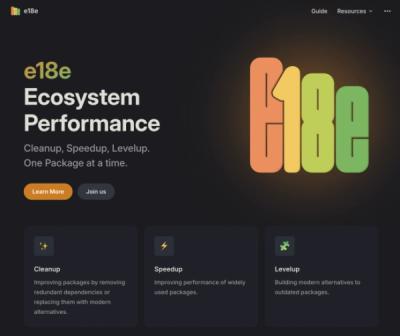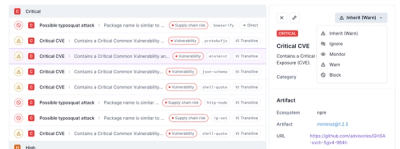
Research
Security News
Malicious npm Package Typosquats react-login-page to Deploy Keylogger
Socket researchers unpack a typosquatting package with malicious code that logs keystrokes and exfiltrates sensitive data to a remote server.
@shopify/react-hooks
Advanced tools
Readme
@shopify/react-hooksA collection of primitive React hooks.
$ yarn add @shopify/react-hooks
useDebouncedValue()This hook provides a debounced value.
function MyComponent() {
const [searchValue, setSearchValue] = useState('');
const debouncedSearch = useDebouncedValue(searchValue);
const {data, loading} = useQuery(SomeQuery, {
variables: {
query: debouncedSearch,
},
});
function handleSearchTextChange(evt: React.KeyboardEvent) {
setSearchValue(evt.currentTarget.value);
}
return <input onChange={handleSearchTextChange} />;
}
useDelayedCallback()This hook provides a delayed callback function. It takes a callback and a delay in milliseconds. This might be useful when you want to invoke a callback after a certain delay.
function MyComponent() {
const delay = 300;
const callback = () => {
console.log(
`Oh, you KNOW I'm calling that callback after ${delay} milliseconds!`,
);
};
const callbackWithDelay = useDelayedCallback(callback, delay);
const onClick = () => {
callbackWithDelay();
};
return <button onClick={onClick}>Click me!</button>;
}
useForceUpdate()This hook provides a forceUpdate function which will force a component to re-render. This might be useful when you want to re-render after a mutable object gets updated.
const mutableObject = {foo: 'bar'};
export default function ResourceListFiltersExample() {
const forceUpdate = useForceUpdate();
const onClick = () => {
mutableObject.foo = 'bar' + new Date().getTime();
forceUpdate();
};
return <button onClick={onClick}>Click Me</button>;
}
useOnValueChange()This hook tracks a given value and invokes a callback when it has changed.
function MyComponent({foo}: {foo: string}) {
useOnValueChange(foo, (newValue, oldValue) => {
console.log(`foo changed from ${oldValue} to ${newValue}`);
});
return null;
}
useTimeout()This hook provides a declarative version of setTimeout(). The first argument is a callback that will be invoked after the given delay (number of milliseconds) as the second argument. Optionally, the timeout can be disabled by passing null as the delay.
function MyComponent() {
const [status, setStatus] = React.useState('Pending');
const pending = status === 'Pending';
const buttonLabel = pending ? 'Cancel' : 'Reset';
const handleClick = () => setStatus(pending ? 'Cancelled' : 'Pending');
const delay = pending ? 1000 : null;
useTimeout(() => setStatus('Fired'), delay);
return (
<div>
<div>{status}</div>
<button onClick={handleClick}>{buttonLabel}</button>
</div>
);
}
useInterval()This hook provides a declarative version of setInterval. The first argument is a callback that will be invoked successively after the given delay (number of milliseconds) as the second argument. Optionally, the interval can be disabled by passing null as the delay.
function MyComponent() {
const [counter, setCounter] = React.useState(0);
const [enabled, setEnabled] = React.useState(true);
const delay = enabled ? 1000 : null;
const label = enabled ? 'Disable' : 'Enable';
const toggle = () => setEnabled(!enabled);
useInterval(() => setCounter(counter + 1), delay);
return (
<div>
<div>{counter}</div>
<button onClick={toggle}>{label}</button>
</div>
);
}
This is a TypeScript implementation of @gaeron's useInterval hook from the Overreacted blog post.
useIsomorphicLayoutEffect()This hook is a drop-in replacement for useLayoutEffect that can be used safely in a server-side rendered app. It resolves to useEffect on the server and useLayoutEffect on the client (since useLayoutEffect cannot be used in a server-side environment).
Refer to the useLayoutEffect documentation to learn more.
useLazyRef()This hook creates a ref object like React’s useRef, but instead of providing it the value directly, you provide a function that returns the value. The first time the hook is run, it will call the function and use the returned value as the initial ref.current value. Afterwards, the function is never invoked. You can use this for creating refs to values that are expensive to initialize.
function MyComponent() {
const ref = useLazyRef(() => someExpensiveOperation());
React.useEffect(() => {
console.log('Initialized expensive ref', ref.current);
});
return null;
}
useMedia() & useMediaLayout()This hook listens to a MediaQueryList created via matchMedia and returns true or false if it matches the media query string.
useMediaLayout is similar to useMedia but it uses useLayoutEffect internally to re-render synchronously.
function MyComponent() {
const isSmallScreen = useMedia('(max-width: 640px)');
return (
<p>
{isSmallScreen ? 'This is a small screen' : 'This is not a small screen'}
</p>
);
}
useMountedRef()This hook keeps track of a component's mounted / un-mounted status and returns a ref object like React’s useRef with a boolean value representing said status. This is often used when a component contains an async task that sets state after the task has resolved.
import React from 'react';
import {useMountedRef} from '@shopify/react-hooks';
function MockComponent() {
const [result, setResult] = React.useState();
const mounted = useMountedRef();
async function handleOnClick() {
const result = await fetchData();
if (mounted.current) {
setData(result);
}
}
return (
<button onClick={handleOnClick} type="button">
Fetch Data
</button>
);
}
usePrevious()This hook stores the previous value of a given variable.
function Score({value}) {
const previousValue = usePrevious(value);
const newRecord = value > previousValue ? <p>We have a new record!</p> : null;
return (
<>
<p>Current score: {value}</p>
{newRecord}
</>
);
}
useToggle()This hook provides an object that contains a boolean state value and a set of memoised callbacks to toggle it, force it to true, and force it to false. It accepts one argument that is the initial value of the state. This is useful for toggling the active state of modals and popovers.
function MyComponent() {
const {
value: isActive,
toggle: toggleIsActive,
setTrue: setIsActiveTrue,
setFalse: setIsActiveFalse,
} = useToggle(false);
const activeText = isActive ? 'true' : 'false';
return (
<>
<p>Value: {activeText}</p>
<button onClick={toggleIsActive}>Toggle isActive state</button>
<button onClick={setIsActiveTrue}>Set isActive state to true</button>
<button onClick={setIsActiveFalse}>Set isActive state to false</button>
</>
);
}
FAQs
Unknown package
The npm package @shopify/react-hooks receives a total of 82,968 weekly downloads. As such, @shopify/react-hooks popularity was classified as popular.
We found that @shopify/react-hooks demonstrated a healthy version release cadence and project activity because the last version was released less than a year ago. It has 24 open source maintainers collaborating on the project.
Did you know?

Socket for GitHub automatically highlights issues in each pull request and monitors the health of all your open source dependencies. Discover the contents of your packages and block harmful activity before you install or update your dependencies.

Research
Security News
Socket researchers unpack a typosquatting package with malicious code that logs keystrokes and exfiltrates sensitive data to a remote server.

Security News
The JavaScript community has launched the e18e initiative to improve ecosystem performance by cleaning up dependency trees, speeding up critical parts of the ecosystem, and documenting lighter alternatives to established tools.

Product
Socket now supports four distinct alert actions instead of the previous two, and alert triaging allows users to override the actions taken for all individual alerts.